As I sit writing this with the rain drumming down outside, I have a sense of relief on a couple of counts. Firstly, because the countryside and rivers are getting some water; levels on some venues are as low as I have ever seen them. Equally though, this year’s freak weather has almost made us forget how fickle the British summer usually is, so I’m also pleased to have got out on the waves while the going was good. After all, tabloid headlines aside, there are few guarantees that 2018’s heatwave will hold.
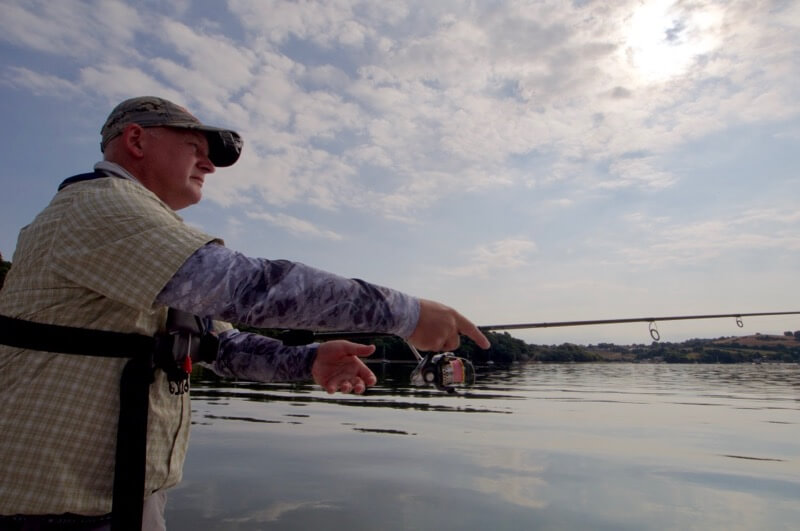
Whether it’s with lures or flies these days, I do love targeting saltwater as often as I can. Usually my efforts are confined to shore marks or from the kayak though, so the offer of a day out with Gary Pearson and the much greater comfort of Chris Guest’s boat was simply too good to pass up. And so we headed out to the River Dart Estuary, hoping for some exciting fly and lure fishing off the South Devon coast.
We’d met on a day out with the South West Fishing For Life group (recently covered in my “Lines on the Water” blog: https://linesonthewater.anglingtrust.net), where Chris is a regular volunteer doing excellent work. It turned out we had a lot of similar tastes with fishing, too, from crossing into coarse fishing to enjoying small streams across the region (Chris runs Exmoor Fly Fishing, for any of you looking to crack at some beautiful small river beats).

What an exciting session it turned out to be, too, thanks in no small part to his excellent local knowledge. In fact, as soon as I saw the skull and crossbones on his boat (essential as far as I’m concerned), along with loads of lure and tackle stickers dotted around, I knew it would be a fun day out with plenty of laughs.
We had both lure and fly tackle at our disposal, and as we made our way out of the river we found bass right from the get go. Like many other estuaries, there is no commercial fishing now on the Dart; this has helped create an explosion of juvenile bass, which certainly bodes well for the future.
Anywhere we found birds going for fry, in fact, small schoolies were there for the asking on a small, debarbed sandeel (I really rate Chris Ogborne’s patterns, in olive or chartreuse, which you can order HERE). The larger patterns, meanwhile, would come into play once we were out at sea, hopefully with the chance of something bigger. Another good idea, regardless of your preferred fly patterns, is to pack a comb to straighten out your patterns when they take a battering from the fish or the elements.
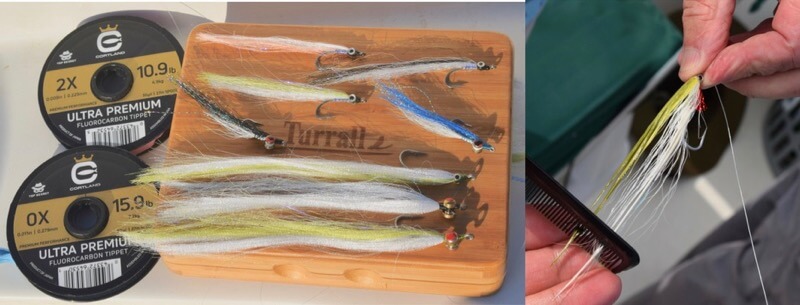
Once we hit the open coast, you could have squinted and imagined you were in Florida or the Med, so sparkling and clear were the waters off the South Hams. Hats and sunblock were used judiciously, while we also went barefoot on deck. Not only is this more comfortable, but gives you a better feel of where the flyline is so you spend less time stepping on it (something my size 14 feet are always good at!).
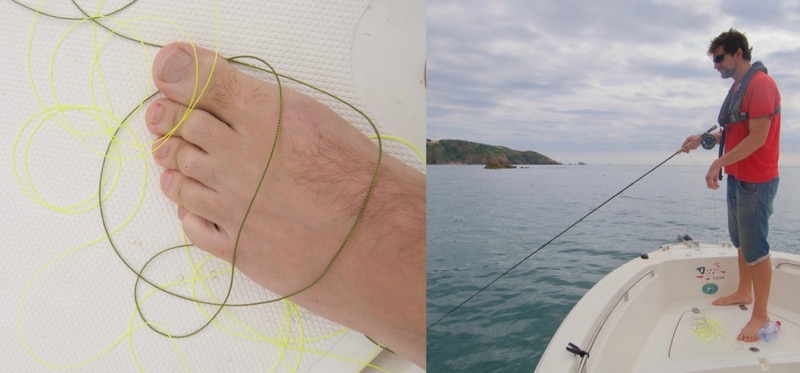
Bass fly fishing tips
While I rarely get too techy on this blog, I always like to pass on some useful stuff where I can- and one of the real perks of what I do is that I get to spend lots of time with those experienced anglers who have real nuggets of wisdom to share.
In terms of tackle, Chris uses full fast intermediate lines for the shallower water, or a fast sink shooting head and running line set up for the deeper stuff. “I think a lot of anglers don’t realise how much denser sea water is to fresh” he muses “lines sink slower in salt water, so you need to make an effort to get them down harder when required.”
I found the casting took some getting used to with a 9wt shooting head (I normally use a fast intermediate line from the shore). Having been taught in the States, Chris reminisced about a guide who would literally smack the back of his head for making too many false casts, along with the imperative to “get the damned thing wet!” Most of us make too many “falsies”, to be truthful. With the shooting head, once you have the heavy section clear of the rings, it’s a case of making just one good haul and just letting the running line follow out smoothly.
Our typical spots were between 15 and 25ft deep much of the time. Bass will come up and hit to some extent, but you need to get as close as you can to their level, so counting to different depths makes perfect sense, from five to twenty seconds. The same is true with lures, of course!
One last thing to mention with kit for punishing fishing is top quality fluorocarbon. Why is it that most of us will say nothing at £200 for a rod, but immediately grit our teeth at the suggestion of paying a bit more for leader materials, I wonder? It could easily be the difference between catching or losing that big fish. The brand is up to you but my advice would be to always go for quality- don’t let your results suffer for the sake of a measly few quid saved. Cortland fluorocarbon is a point in case; rather pricey, but so much better than budget crap.
Lure fishing for wrasse
Beautifully smooth water and clear skies might have supplied the illusion that we might be in the Dominican Republic rather than outside Dartmouth, but also made fishing in the morning a challenge. So, with time on our side Chris suggested we try for wrasse over rough ground. A great shout for some welcome variety, as it turned out.

Using rubber lures such as crayfish copies and X-Layers, several juicy hits were forthcoming too. It was a new technique for Gary, who we advised to slow down retrieves to keep the lure on the deck- but once he got the hang of it, he was rewarded with a massive thump and a real dog of a wrasse at four pounds plus! With the terrain involved, it’s not hard to see why 20lb line and tough leaders are required for these fish.
Otherwise, numbers of fish in the one to two pound stamp were plentiful- and an absolute delight in the clear conditions. Even fifteen feet below the boat I could see my lure working and actually witnessed a number of follow and grab sequences. The wrasse often seemed to have a look and then take two or three snatches at the lure, before getting hooked or missing, which was interesting. Without the benefit of this view, I wouldn’t have felt several of the bites.
Some takes were bolder, certainly, but other attackers would take a closer look and then back off. Fascinating fishing and a great way to spend a couple of hours while the bass are absent. And exploring the coast two friends on a beautiful day, while casting and putting the world to rights is surely what the summer is made for?
Tide rips and rock marks
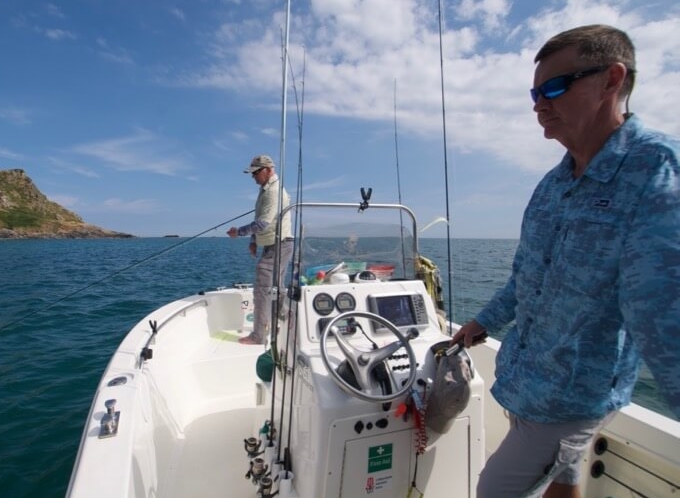
If our morning’s fishing was in danger of becoming rather laid back, the afternoon saw a return to some more typical bass spots and conditions. The wind picked up, which helped a lot, and I noticed that the harder it became to stand up straight on deck, the better the fishing got! Of course, a cross wind can also help with boat fishing, because you can then drift and cover the ground better. In some ways it’s rather like drifiting for trout with loch style fishing, aiming to run parallel to the shore.
We also tried some tide rips and rocky places- spots where local knowledge is a must not only for the fishing but for safety. I’m not about to signpost the best spots for bass around the Devon coast here (you have eyes, maps and brain cells after all; unfortunately so do the netsmen!), but suffice to say there are spots where you need to be rather careful. It’s often a case of one man keeping the boat steady, while others fish. Two fly lines flailing about can be risky too, so we took turns giving one angler fly casting room, while the other had a crack with the lure rod.
Some of the more turbulent spots were almost like a salmon fishing run. Usually, it’s difficult to work a fly too fast for bass – and the roly poly retrieve is handy (if anything, a lot of us work our flies and lures too slowly, which is another good fishing tip for sea bass). But where the current sweeps through, you can slow right down and let your fly or lure swing through with the occasional twitch, or impart some action just by lifting and dropping the rod tip.
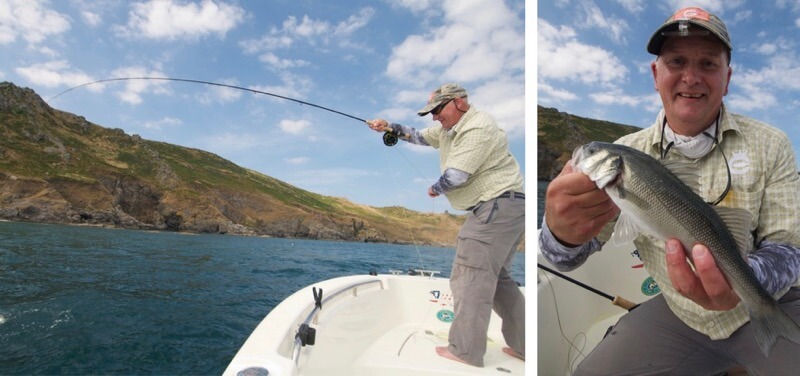
Sudden thumps and hits confirmed the theory and we were finally into the bass. I managed a small one, followed by several shoal mates, on a Savage Gear Sandeel, before Gary got one on the fly, greeted by cheers from us!
Chris refuses to take a single one of these beautiful fish home for the table- an attitude I completely share. Obviously it’s my personal opinion, but I do wonder if we shouldn’t make bass fishing 100% catch and release? This would be my preferred option. After all, it’s not like any of us are starving and with a 4lb bass likely to be over ten years old, do we really need to take them home to eat?
Celebrity chefs have a lot to answer for in making these precious slow-growing fish so fashionable to cook, and I couldn’t put it better than Chris, who also supports the Angling Trust and Bass Anglers’ Sportfishing Society: “I want there to still be plenty of bass around for my kids and grandkids to catch.”
Drifting on…
The fishing got better as the afternoon wore on. It was very much a case of covering plenty of ground and only retracing a drift where bites had occurred. We didn’t get any real brutes, but if there’s any fish that can convince you you’ve hooked something twice as heavy, it’s a bass.
It got increasingly difficult to wrestle the fly rod off Gary, but I was more than content throwing lures, a method I also love. It was nice to go old school, too, and ditch the soft rubber lures for some diving plugs and topwaters on a regular basis, taking things back to my first attempts to catch bass some 28 years ago. Again, Chris had one or two key local tips that helped.
One was a lure that would certainly not have been my first, second or third choice, in the form of a fairly drab olive-backed floating plug. Granted, so it did look just like a small pollack, but in some 20ft of water I wouldn’t have expected it to run deep enough?
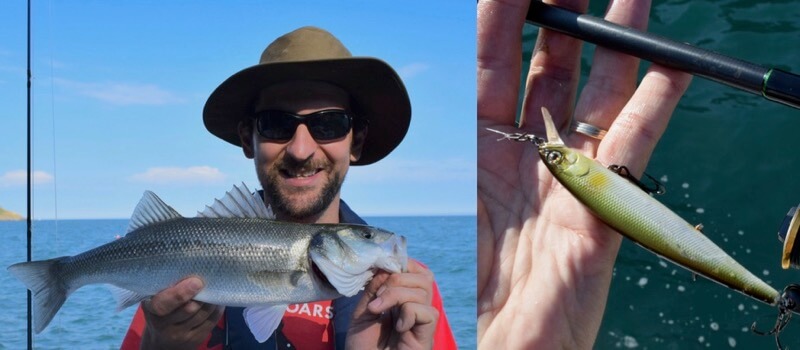
How wrong I was, though, as it worked a treat. The theory is that on a warm day, small pollack quite often bask in the sun, well off the bottom. And a 6” sample is just a snack for the gaping jaws of a passing bass.
The way the reel groaned and the rod locked up on the next hit, I fancied I might have a six-pounder, but the fish that came in was less than half that size, but bristling with power and attitude. Wonderful sport!
A couple more came our way, too, before time beat us and we had to travel back to the Dart Estuary. Beaches flew by, dotted with summer mackerel anglers and scorched sunbathers. With a coastline as beautiful as ours in South Devon, the hours can pass quickly, which is always a sure sign that you’ve had an enjoyable day.
There were wading birds and signs of life all over the Dart on the way home. Even the actual boat jetty was swarming with fry and the baby bass that will hopefully give us sport for years to come. We were willing to drink to that with a quick pint on the way home, anyway, to celebrate a fine day and thank Chris for having us on board to share it.
Further blogging and current news…
It can be a tricky business keeping this blog updated regularly, but before I go I should also tell you about some other great reading material this month. First up, issue number 13 of quarterly bookazine Fallon’s Angler is out right now for you to enjoy. There are cracking articles from fishing legend Chris Yates, angler artist Scott Winstanley and many others, as well as my reflections on match fishing and The General going deep sea fishing (well, extreme deep sea fishing in the Mariana Trench, to be precise). See http://fallonsangler.net to order your copy.
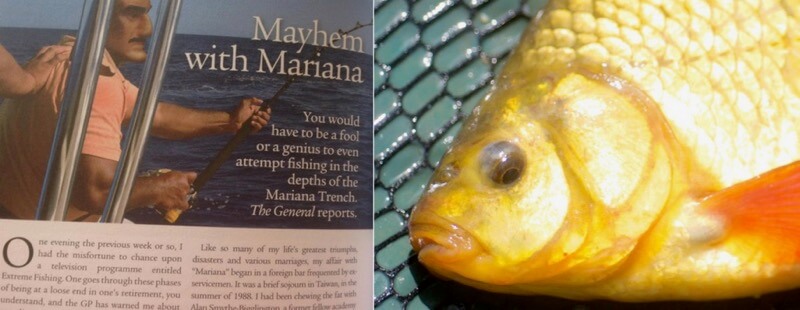
Otherwise, you can catch me every week in the Angling Times with my column “The Far Bank”, while I’ve also been busy writing on subjects from crucian carp fishing to the perils of invasive species on the Angling Trust’s “Lines on the Water” blog (http://linesonthewater.anglingtrust.net/).
If there is anything you would like to see me write about, or any issue that’s pressing in your angling world at the moment, you’re always welcome to get in touch, too (dominic.garnett@anglingtrust.net). If there’s a story there I am always interested.
All the best for now and tight lines if you’re out fishing this week!


